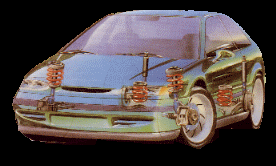Suspension Systems

Suspensions are the elastic components which are put between wheels and frame to absorb shocks from traveling over rough roads or bad road conditions ,making drive more comfortable and safety , keeping the tires in contact with the road.To understand suspensions’ use you have to know the term handling.Vehicle geometry, suspension, and steering design all affect vehicle’s handling , which born from the following fundamentals on the whole :
So, to a great extent, handling depends on optimizing the vehicle's suspension dynamics, or dynamic control. This means that when a vehicle is in motion, all the components in the suspension system work together effectively to provide tire-to-road contact. The amount of this traction force between the tires and the road is the major factor in how well a vehicle can maneuver through corners, or as it stops and accelerates.For that the components of the suspension systems perform five basic functions: maintain correct vehicle ride height ,reduce the effect of shock forces , maintain correct wheel alignment ,support vehicle weight ,keep the tires in contact with the road ,control the vehicle's direction of travel.

Comfort and Safety.
The suspension systems allows the vehicle body to ride relatively undisturbed while traveling over rough roads. It also allows the vehicle to corner with minimum roll or sway, stop with a minimum of brake dive, and accelerate with a minimum of acceleration squat, keeping the tires in contact with the road.For that suspension systems are not only necessary for improving a vehicle's riding comfort and handling. Because their job is to help keep tires on the road is very important to have a vehicle riding without worn shocks and struts that do unsafe the moving not only for the driver and passengers, but also for the other vehicles on the road. Worn shocks and struts can allow excessive vehicle weight transfer from side to side and front to rear...and that reduces the tire's ability to grip the road. Because of this variation in tire-to-road contact, a vehicle's handling and braking performance can be reduced. This may affect the safe operation of the vehicle and the safety of those riding inside. Therefore, shocks and struts ARE SAFETY COMPONENTS.
Main Components.
The main components of a moving vehicle's suspension system are the struts, shock absorbers, springs, and tires. Struts are a major structural member, while shock absorbers are a major component. The struts and shock absorbers control, or damp, excessive spring and suspension movement.
The springs support the weight of the vehicle, maintain ride height, and absorb road shock. Springs are the flexible link that allows the frame and body to ride relatively undisturbed while the tires and suspension follow the bumps in the road.Springs are the compressible link between the frame and the body. When additional load is placed on the springs, or the vehicle meets a bump in the road, the springs will absorb the load by compressing. The springs are a very important component of the suspension system that provides ride comfort. Shocks and struts help control how fast the suspension is allowed to move which is important in keeping the tires in firm contact with the road.
During the study of springs, the term bounce refers to the vertical (up and down) movement of the suspension system. The upward suspension travel that compresses the spring and shock absorber is called jounce, or compression. The downward travel of the tire and wheel that extends the spring and shock absorber is called rebound, or extension.
When a spring is deflected, it absorbs energy. Without shocks or struts, the spring will extend and release this energy at an uncontrolled rate. The spring's inertia causes it to bounce and over-extend itself. Then it re-compresses, but will again travel too far. The spring continues to bounce at its natural frequency until all the energy originally put into the spring is used up by friction.If the struts or shock absorbers are worn and the vehicle meets a bump in the road, the vehicle will bounce at a frequency of the suspension until the energy of the bump is used up. This may allow the tires to lose contact with the road.Struts and shock absorbers that are in good condition will allow the suspension to oscillate only through one or two diminishing cycles, limiting or damping excessive vibration.
By controlling spring and suspension movement, components such as ball joints and tie rods will operate within their design range and, while the vehicle is in motion, dynamic alignment will be maintained.